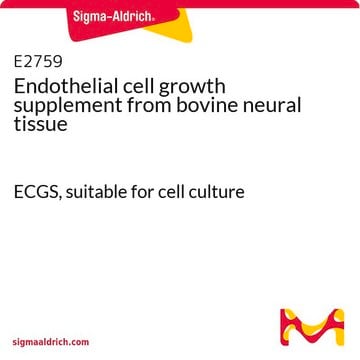This medium is a complete, ready-to-use product; no supplementation is required. This formulation contains hydrocortisone, heparin and other growth factors needed to support Endothelial Cell growth. Unless a suspension culture is required, the culture vessel should be tissue culture treated. The additional use of attachment matrices such as gelatin, would be dependent on the requirements of the specific cell line or type.
211-500
Endothelial Cell Growth Medium (500 ml)
Sinónimos:
Primary Cell Culture Media
Seleccione un Tamaño
MXP 3,700.00
Fecha estimada de envío28 de marzo de 2025
Seleccione un Tamaño
About This Item
MXP 3,700.00
Fecha estimada de envío28 de marzo de 2025
Productos recomendados
form
liquid
Quality Level
shelf life
6 mo.
manufacturer/tradename
Cell Applications, Inc
shipped in
wet ice
storage temp.
2-8°C
General description
Application
Quality
Preparation Note
Storage Class
12 - Non Combustible Liquids
wgk_germany
WGK 1
flash_point_f
Not applicable
flash_point_c
Not applicable
Elija entre una de las versiones más recientes:
Certificados de análisis (COA)
¿No ve la versión correcta?
Si necesita una versión concreta, puede buscar un certificado específico por el número de lote.
¿Ya tiene este producto?
Encuentre la documentación para los productos que ha comprado recientemente en la Biblioteca de documentos.
Artículos
Medium 199 supports non-transformed cell cultivation in virology and vaccine production, offering broad species applicability.
Protocolos
Technical information for working with human pulmonary artery endothelial cells including thawing, subculturing and cryopreservation
Technical information for working with human aortic endothelial cells including thawing, subculturing and cryopreservation.
Human Umbilical Vein Endothelial Cells (HUVEC) Culture Protocol. Storage. Preparation for Culturing. Store the cryovials in a liquid nitrogen storage tank immediately upon arrival.
-
If I use this medium, do I need to use tissue coated treated flasks with gelatin? Does this medium need to be supplemented with heparin or is it already included?
1 answer-
Helpful?
-
-
Can you please provide the full composition of the medium with the concentrations?
1 answer-
This item is a product of Cell Applications. The formulation is considered proprietary. However, this medium does include glucose at 1g/L, 2% Fetal Bovine Serum, as well as Penicillin, streptomycin, and Amphotericin B. Some salt components have also been published in the Safety Data Sheet.
Helpful?
-
-
Do you sell glucose-free ECGM? I needed it for HUVEC cells. 0mM glucose.
1 answer-
This product is not a glucose-free medium. The formulation contains 5.78 mM glucose which is 5.55 mM after all the supplements are added. Unfortunately, a glucose-free ECGM medium is not currently offered.
Helpful?
-
Active Filters
Nuestro equipo de científicos tiene experiencia en todas las áreas de investigación: Ciencias de la vida, Ciencia de los materiales, Síntesis química, Cromatografía, Analítica y muchas otras.
Póngase en contacto con el Servicio técnico



